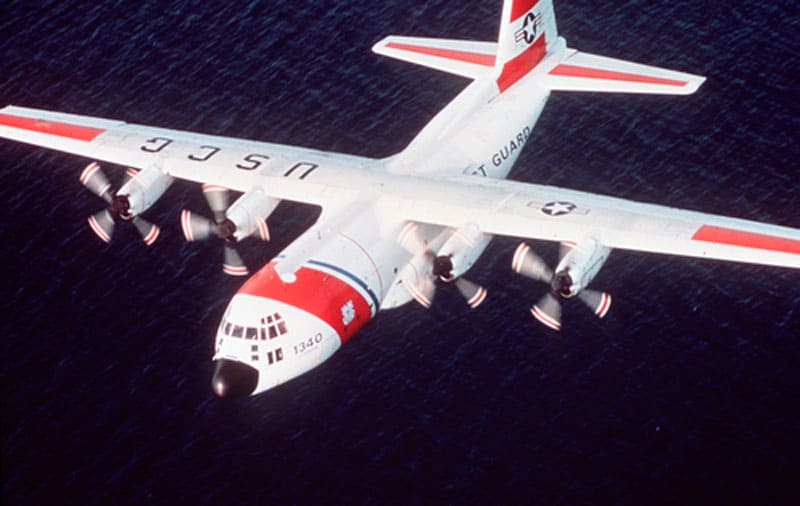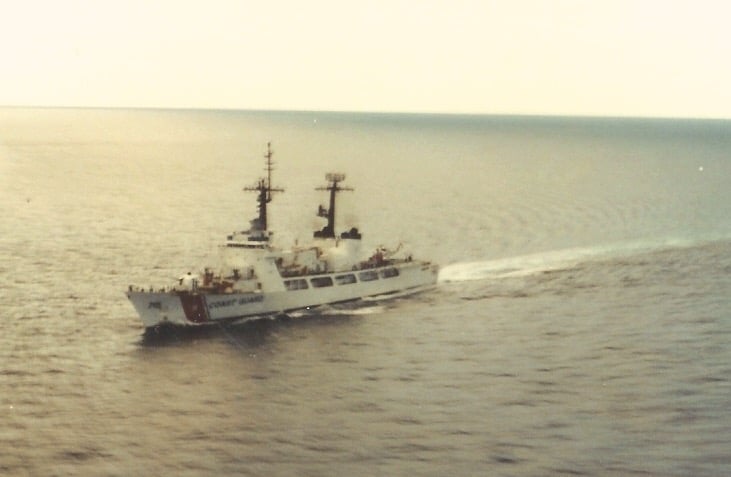WHEC Coast Guard Cutter Chase with HH-52 on board
The Cuban exodus of 1980 changed the response to illegal immigration from the Caribbean. Skilled immigrants from Jamaica and Haiti, both Afro-Caribbean groups, arriving between 1965 and 1980 passed into American society almost unnoticed. The pre-1980 Cuban migrants received all kinds of state assistance facilitating incorporation and were highly successful, in large part because of the willingness of the existing Cuban exile community to absorb them. In the period between the 1980 Cuban exodus, until the terrorist attacks in 2001, immigration policies were shaped primarily by domestic concerns. Between 1970 and 1980 there were a little over 56,000 Haitians that immigrated legally and as many as 90,000 that immigrated illegally. The illegals transited 700 miles of open ocean in unseaworthy, overcrowded, sailing vessels and a number had drowned in the attempt to reach the South Florida beaches. Thousands had been arrested and detained awaiting deportation. Thousands more, who had either put up their lifelong savings or sold themselves into bondage to reach the United States, evaded the Immigration Service (INS) and were assimilated into a rapidly growing “little Haiti” in Miami. They were largely unskilled and from the rural sections of Haiti with an annual per capita income of less than $300 per year. A high incidence of HIV/AIDS infection compounded the problem. The economic impact on South Florida was staggering. By early 1981 almost $467K per day was being spent to care, feed, clothe, and provide medical attention for the illegal arrivals. The political pressure was intense to stop the flow. A September 23, 1981, agreement between the United States and the Republic of Haiti, permitted the United States to stop (interdict) boatloads of Haitians attempting to reach the United States and return them to Haiti. This Agreement provided the legal basis for President Reagan’s September 29, 1981, finding (Presidential Proclamation Order 4865) and authorization (Executive Order 12324) for what became known as the Haitian Migrant Interdiction Operation (HMIO).The State Department and the Immigration and Naturalization Service established and promulgated procedures to block and deter smugglers bringing Haitians to the United States. The responsibility for implementing the program was given to the Coast Guard.
Lessons learned from the Mariel Exodus clearly showed that it would be much more effective to stop the flow of illegal immigration at the source and that the combination of air and surface assets was most productive. A force package of consisting of a High Endurance Cutter (WHEC) an HC-130 and two HH-52 helicopters, augmented with medical teams and Immigration Service personnel, was drawn up to patrol the international waters surrounding Haiti to identify, examine, board and interdict suspect vessels bound for the United States. The Coast Guard was already preparing an extensive drug interdiction campaign together with the Drug Enforcement Agency and the U.S. Customs Service to thwart the lower Caribbean drug pipeline. The Service piggy-backed the two operations.
Naval Air Station Guantanamo Bay, Cuba was the most suitable site for aviation support to the On-Scene Commander, whose vessel would patrol the Old Bahama Channel and Windward Passage in an arc around Port du Paix on the Haitian northwest coast. Extensive negotiations with the Commander, Naval Base Guantanamo Bay (GTMO) Cuba resulted in an excellent relationship under an Interservice Support Agreement (ISSA) to provide operations, maintenance, supplies and living accommodations for thirty-five Coast Guard aviation officers and enlisted personnel a NAS Leeward Point.

Utilizing the experience gained from AVDET Key West, representatives from the Seventh District Operations, Air Station Miami and Air Station Clearwater drafted detailed Operation Orders, well in advance, to delineate personnel tasking, a concept of daily flight support, a communications plan, and aircraft maintenance/supply procedures. Support for the operation was provided by the Seventh Coast Guard District with Air Station Clearwater providing operational and logistical support and Air Station Miami providing the helicopter maintenance support. HC-130 aircraft were deployed to GTMO (Naval Air Station Guantanamo Bay, Cuba) from CG Air Station Clearwater on a weekly basis. While at GTMO they flew four to five hour surveillance patrols. During the initial period HH-52 helicopters and crews from Air Stations Traverse City, Brooklyn, Savannah and Miami rotated through the AVDET. Two HH-52s were attached to the AVDET at a time. The helicopters alternated between a week at sea onboard the WHEC and a week ashore at the AVDET for maintenance and logistical service to the cutter. The deployed helicopter ranged extensively throughout the flying area. Three C-130 loads of personnel, ground support equipment, a communications van, and an extensive HH-52/HC-130 spare parts allowance began to arrive in GTMO on 5 October 1981. Four days later USCG Aviation Detachment (AVDET) Guantanamo Bay, Cuba became an operational reality. The Aviator-in-Charge concept was again utilized and LCDR Mont J. Smith was assigned this responsibility.

A typical interdiction was similar to one which occurred in late October. An HH-52 sighted an unseaworthy and overloaded sailing vessel. The USCGC Chase intercepted and removed fifty-six Haitians from the now sinking thirty-five foot vessel. As soon as they arrived aboard the Chase, all were given medical examinations and then they were extensively interviewed by the Immigration Service Officer through the Immigration interpreter to determine if any had valid claims of asylum in the United States. None made claim for asylum and they were returned to Port Au Prince where they were met by officials of the Government of Haiti, the Haitian Red Cross and staff from the American Embassy.
Commenting on the operation, CAPT Douglass Currier, the Commanding Officer of the Chase said that without the helicopter the interception would probably not have been made and the Haitians would have perished at sea. Coincidentally, interception and seizure of drug smuggling vessels had increased considerably since the beginning of the operation. By mid November the seizure of the fifth drug ship had occurred. The estimated street value of the drugs totaled more than $14 million. When the Chase was relieved on station in early December CAPT Currier sent a message to the AVDET, information to the Seventh District, praising the flight crews for their skill, dedication, support and professionalism displayed. The message included his personal BZ.
The AVDET Guantanamo Bay was a continuing success. Once again the concept had been proven. During drug interdiction activities in 1984-85 an AVDET was established at Curacao. AVDET GTMO was used during the late ‘80s for air interdiction missions and again in 1994-95 during a peak interdiction period as well as a number of times since. The AVDET is maintained in a skeletal form and is fully activated when operations dictate. During 2008 HU-25 aircraft operated out of GTMO on interdiction missions and HH-65 helicopters support the Coast Guard Port Security Detachment.


